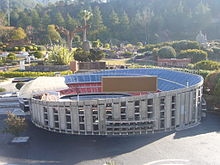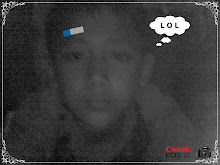Camp Nou (Catalan pronunciation: [kamˈnɔw], "New Ground"), sometimes called "the Nou Camp" in English, is a football stadium in Barcelona, Catalonia,Spain. The stadium, located in the west of the city, has been the home of FC Barcelona since its construction in 1957.
The Camp Nou seats 99,354[1], reduced to 96,336 in matches organized by the UEFA,[2] making it the largest stadium in Europe and the eleventh largest in the world in terms of capacity. It has hosted numerous international matches at a senior level including two UEFA Champions League finals, the most recent being in 1999. It also hosted several games, including bronze- and gold-medal matches, for the football competition at the 1992 Summer Olympics hosted by Barcelona. It held UEFA five-star status until 2006, when a new rating system was introduced by UEFA.
Its official name was Estadi del FC Barcelona (FC Barcelona Stadium) until 2000, when the club members voted to formally adopt the popular nicknameCamp Nou. Though opposed by current club president Sandro Rosell, FC Barcelona initially approved the sale of its former training ground Mini Estadi to remodel the stadium on its fiftieth anniversary and increase capacity to 104,000 in 2007. The plans are on hold because of the World financial crisis.
Contents[hide] |
[edit]History
[edit]Construction
The construction of Camp Nou started on 28 March 1954 as Barcelona's previous stadium, Camp de Les Corts had no room for expansion. Although originally planned to be called Estadi del FC Barcelona, the more popular name Camp Nou was used. The June 1950 signing of László Kubala, regarded as one of Barcelona's greatest players provided further impetus to the construction of a larger stadium.[3][4][5]
Construction of Camp Nou began on 28 March 1954 before a crowd of 60,000 Barça fans. Civil governor of Barcelona, Felipe Acedo Colunga presided at the laying in place of the first stone, with a blessing from the Archbishop of Barcelona, Gregorio Modrego. Construction took three years, going 336% over budget for a final cost of 288 million pesetas.[5] The stadium was officially opened on 24 September 1957. Handel's Messiah was performed at the opening of the stadium.
The architects were a team made up of Francesc Mitjans, Josep Soteras and Lorenzo García-Barbón.
[edit]Early years
In May 1972, Camp Nou hosted its first European Cup Winners' Cup final between Rangers and Dynamo Moscow. Rangers won the match with a score of 3–2. The 1970s marked a turning point for FC Barcelona with the signing of new player, Johan Cruyff in 1973. Electronic scoreboards were installed in the stadium two years later.
The stadium underwent an expansion in 1980, in anticipation of the 1982 FIFA World Cup, which added boxes, VIP lounges, a new press area, new markers and the enlargement of the third tier by 22,150 seats for a total capacity of 115,000 spectators. The club raised funds for the remodeling by inscribing thousands of supporters’ names on bricks in return for a small set donation. This later became a topic of controversy when the news media in Madrid reported that the name of long-time Real Madrid chairman and Franco supporter, Santiago Bernabéu, had been commemorated in this way.[6][7][8] The first important game played was the final of the Winners’ Cup featuring Barcelona against Standard Liège, on 12 May 1982. Barcelona won the game 2–1 in front of an audience of 80,000.
Camp Nou was one of several stadiums used throughout the 1982 World Cup, hosting the inauguration ceremony on 13 June. Before a 100,000-person crowd,Belgium upset the defending champions Argentina 1–0 in the match that followed.[9]
[edit]Development
The stadium’s capacity has varied greatly over the years, opening at 106,146, but growing to 121,749 for the 1982 FIFA World Cup.
Apart from hosting FC Barcelona, Camp Nou is home turf to the Catalan national team, their latest match as of August 2010 being a 4–2 win over Argentina.[10] The stadium is frequently used for other football events. The European Cup final between A.C. Milan and Steaua Bucharest was held on 24 May 1989, with the Italian club winning 4–0.[11] Camp Nou hosted part of the football competition, including the final, in the 1992 Summer Olympics.[12] In preparation for these Games, two additional tiers of seating were installed over the previous roof-line.[13]
Camp Nou underwent little change after 1982, except for the opening of the club museum in 1984. The stadium underwent a facelift in 1993–94, in which the pitch was lowered by 2.5 m (8 ft), the security gap that separated the lawn from the galleries was removed, and standing room was eliminated in favor of individual seating. A new press box, renovation of the presidential grandstand and boxes, new parking under the main grandstand, and new lighting and sound systems were completed in time for the 1998–99 season. In 1999 the UEFA outlawed standing sections in stadiums, and Camp Nou’s capacity settled to its current level.[1] The stadium hosted the 1999 UEFA Champions League Final later that year where Manchester United played Bayern Munich. United won 2–1, coming back from 0–1 down in injury time.[14]
In 2000, fans were polled concerning the stadium’s name. Of the 29,102 votes the club received, a total of 19,861 (68.25%) preferred Camp Nou to Estadi del FC Barcelona, and thus the official name was changed to the popular nickname.[15]
During 1998–99, UEFA rated Camp Nou a five-star stadium for its services and functionalities.[16] However, as per the 2010 regulations, UEFA does not publish a list of the top venues.
The facilities now include a memorabilia shop, mini-pitches for training matches, and a chapel for the players. The stadium also houses the second-most visited museum in Catalonia, FC Barcelona Museum, which receives more than 1.2 million visitors per year.[17]
[edit]Future
To celebrate the fiftieth anniversary of the stadium, the club issued an international tender to remodel it. The objective was to make the facility an integrated and highly visible urban environment. The club sought to increase the seating capacity by 13,500, with at least half of the total seating to be under cover. Should these renovations be completed, the stadium will be the third largest in the world (in terms of seating capacity), after the Rungrado May Day Stadiumin North Korea (150,000 capacity) and the Salt Lake Stadium in India (120,000 capacity).
On 18 September 2007 the British architect Norman Foster and his company were selected to "restructure" Camp Nou. With an estimated cost of €250 million, the plan included the addition of 10,000 seats for a maximum capacity of 106,000.[18] The board of FC Barcelona approved the sale of their former training ground Mini Estadi in order to finance the remodeling. The project was planned to begin in 2009 and to be finished for the 2011–12 season.[19] However, due to the 2008 financial crises and subsequent fall in real estate prices, the sale of the training ground was postponed and likewise the remodeling project. In May 2010 Sandro Rosell, then a candidate for president of FC Barcelona, dismissed the possibility of selling Mini Estadí, saying it would be indefensible to “sell the crown jewels”, and his election on 30 June has effectively halted the plan to remodel Camp Nou.[20][21]
[edit]Other uses
Camp Nou has been used for various purposes other than football, often hosting major concerts.
Pope John Paul II celebrated mass for a congregation of over 121,000 at Camp Nou on 17 November 1982, on the occasion being made an honorary citizen of Barcelona.[22]
In 1983 Julio Iglesias played for 60,000 people, in what was described as a "most beautifully orchestrated" concert.[23] Other high-profile performances at Camp Nou include those by Bruce Springsteen on 3 August 1988 during his Tunnel Of Love Express Tour; and again on 19 July and 20 July 2008 during hisMagic Tour. On 10 September 1988, a charity concert organised by Amnesty International to support human rights featured, among others, Bruce Springsteen, Sting, Peter Gabriel, Youssou N'Dour, Tracy Chapman, and El Último de la Fila. A concert by the Three Tenors—Josep Carreras, Plácido Domingo, and Luciano Pavarotti—was held on 13 July 1997.
On 1 July 2009 the stadium held the launch of the U2 360° Tour, which was attended to the maximum capacity of 90,000 people.[24] The lead singer of U2, Bono, explained that they had started their tour in Camp Nou since “This is where we wanted to build a space station, designed by Gaudi in the capital of surrealism." The concert ended with Bono wearing an FC Barcelona jersey.[25]
On August 9, 1988, Michael Jackson appeared at the stadium in front of 95,000 fans during his Bad World Tour.
















No comments:
Post a Comment